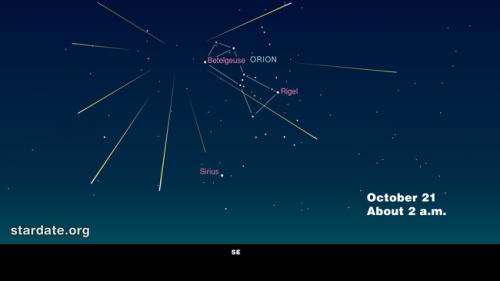Orionid meteor shower peaks Oct. 20-21, 2012

As it does each year, early fall brings crisper air, turning leaves, and the Orionid meteor shower. This year's best viewing will be in the several hours around midnight October 20 and before dawn on October 21, according to the editors of StarDate magazine.
At its late-night peak, this year's shower is expected to produce around 25 meteors per hour. The first-quarter Moon will set around midnight, so its light will not interfere with the celestial show.
Orionid meteors appear to fall from above the star Betelgeuse, the bright orange star marking the shoulder of the constellation Orion. They are not associated with this star or constellation, but instead are leftover debris from Halley's Comet. The Orionid meteors recur each year when Earth passes through the comet's debris trail.
For your best view, get away from city lights. Look for state or city parks or other safe, dark sites. Lie on a blanket or reclining chair to get a full-sky view. If you can see all of the stars in the Little Dipper, you have good dark-adapted vision.
Published bi-monthly by The University of Texas at Austin McDonald Observatory, StarDate magazine provides readers with skywatching tips, skymaps, beautiful astronomical photos, astronomy news and features, and a 32-page Sky Almanac each January. The magazine is available in both print and digital formats.
Established in 1932, The University of Texas at Austin McDonald Observatory near Fort Davis, Texas, hosts multiple telescopes undertaking a wide range of astronomical research under the darkest night skies of any professional observatory in the continental United States. McDonald is home to the consortium-run Hobby-Eberly Telescope, one of the world's largest, which will soon be upgraded to begin the HET Dark Energy Experiment. An internationally known leader in astronomy education and outreach, McDonald Observatory is also pioneering the next generation of astronomical research as a founding partner of the Giant Magellan Telescope.
The production and distribution of StarDate Media is made possible by AEP Texas.
Provided by University of Texas McDonald Observatory





















